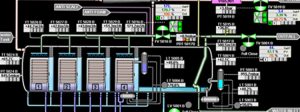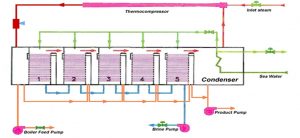 The desalination process of MED-TVC (Multi Effect Desalination With Thermal Vapour Compression) is based on evaporation and condensation of sea water under a high vacuum, this process takes place in some evaporators. These evaporators are often called effects or cells.
The desalination process of MED-TVC (Multi Effect Desalination With Thermal Vapour Compression) is based on evaporation and condensation of sea water under a high vacuum, this process takes place in some evaporators. These evaporators are often called effects or cells.
Sea water is spread as thin film over the horizontal tubes installed inside the evaporators. This water is evaporated by heat transferred from the steam passing inside the tubes. The vapour inside the tubes transfers its thermal energy to sea water and is condensed. The evaporated sea water is then passed through demisters, to prevent carryover of salt. The pure steam then moves to the next effect and transfers heat to the sea water. The generated vapour in this effect is condensed inside the next effect tubes. The product water in each effect (distillate) is cumulated with the subsequent effects’ distillate water. This process continues till the last effect.
The vapour generated in the last effect is divided in two parts:
A portion of it is sucked by thermocompressor because of a supersonic nozzle on it and after mixing with the motive steam enters the first effect tubes.
Using the thermocompressor decrease the amount of energy consumption by recycling a part of steam inside the system.
The other portion of it enters the condenser and is distillated by the inlet water passing through the condenser tubes.
Increasing the number of effects results in more distilled water produced for constant heat energy consumption. Also less sea water and steam is used by increasing the number of effects
The proposed desalination unit mainly consists of 4 effects, a condenser and a thermo compressor, which is a large recycling steam ejector to recover a portion of last effect produced vapour energy that is going to be removed in condenser.
Process Flow Lines
1- Inlet steam to the desalination unit
2- Sea water flow
3- Product water and condensate water
4- Brine flow
5- Non condensable Gasses (NCG) flow
1- Inlet steam to the desalination unit
There are two types of inlet steam to package: 1. High pressure steam (HPS) : The motive steam enters thermocompressor with predetermined thermo-dynamical parameters. Decreasing the pressure of the motive steam in the supersonic nozzle causes a part of produced vapour in the last effect to be transferred to the first effect steam box after mixing with the inlet steam to evaporate the feed water in the first effect.
2. Steam for non-condensable gases (NCG) ejectors (HPS) : Another portion of steam is used to activate a couple of vacuum ejectors and also evacuate non condensable gases from the system. The pressure for these ejectors is 40 barg As well. During the cold start up, two vacuum ejectors in service (hogging) causes fast evacuation of air from system and therefore the desalination unit is rapidly ready for starting up. After achieving sufficient vacuum for operation, one of ejector will be shut down and the other one evacuate NCG during normal operational conditions.
2- Sea water flow
Sea water at first enters the condenser tubes. The water should be free of living organisms. The sea water outlet from condenser is divided into two branches. A portion called cooling water will be drained. The flow of cooling water is varied in correspondence with the sea water temperature and is controlled by the product output temperature. The other portion, which is used as feed water of effects, is divided to four branches; each branch provides the feed water for one effect. After entering the effects through some spray nozzles with specific characteristics, inlet water is sprayed over effect tubes. Some chemicals consist of anti-scale (belgard ev 2050) and anti-foam (belite M8) are added to it to avoid scaling and foaming around the tubes. Feed water flow is also controlled by a flow control valve.
3- Product water and condensate water
Output vapour from thermocompressor is condensed in the first effect tubes and then enters the distillate box. A portion of this water comes from the inlet steam to the thermocompressor and the other part come from the vapour extracted by the thermocompressor from last effect, whose amount is comparable with the inlet steam. This water coming from 1’st effect distillate box can be transferred to second distillate box because of existing a pressure difference between the effects and after assembly with this effect distillate water added to next effect distilled water. At the end of the path a portion of the vapour produced in the last effect, which is distilled in the condenser, is added to final effect product water, which extracted by the product pump.
4- Brine flow
30%-33% of feed water to the effects evaporates and the remaining amount is called brine, which flows toward the next effect. The best performance of the unit for the least amount of scaling is achieved provided the above percentage is considered. In other words, in this unit the concentration factor (C.F.), which is the rate of inlet water feed to the desalination to the output brine, should not exceed 1.5 We use C.F. less than 1.5 (normally 1.45) in our desalination units.
5- Non condensable Gasses (NCG) flow
Non condensable gasses such as air, CO2, O2, N2 and other gases released from sea water are separated during distillation in the effects and transferred to the next effects through the NCG box. In each effect Non condensable gasses extracted from the tubes inside the effect to the second pass of the tube bundles and then to the NCG boxes and by an orifices Non condensable gasses are mixed with the vapor in the next effect. At the end, output NCG from last effect is transferred to the air box in the condenser and added to the condenser NCG extracted through the outlet pipe of condenser’s air box, which is connected to the suction of NCG ejector.

